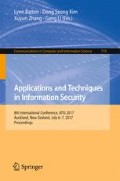Abstract
Secure computation has obtained significant attention in the literature recently. Classic architectures usually use either the Garbled Circuit (GC) or the Goldreich-Micali-Wigderson (GMW) protocols. So far, to reduce the complexity of communications in these protocols, various methods have been proposed. The best known work in both methods reduces the communication up to almost 2k-bits (k is the symmetric security parameter) for each AND gate, and using XOR gate is free. In this paper, by combining GC and GMW, we propose a scheme in the semi-honest adversary model. This scheme requires an Oblivious Transfer (OT) and a 2-bit data transfer for each AND gate, keeping XOR gates free. The analytical results on different applications, including AES, DES, SHA-1, SHA-256, MD5, multiplier, adder, and comparator show that the data transfer size can be reduced up to 52% and 41% when compared to the best known GC and GMW based methods, respectively.
Access this chapter
Tax calculation will be finalised at checkout
Purchases are for personal use only
References
Bringer, J., Chabanne, H., Patey, A.: Privacy-preserving biometric identification using secure multiparty computation: an overview and recent trends. IEEE Signal Process. Mag. 30(2), 42–52 (2013)
Sui, Y., Zou, X., Du, E.Y., Li, F.: Secure and privacy-preserving biometrics based active authentication. In: IEEE International Conference on Systems, Man, and Cybernetics, pp. 1291–1296 (2012)
Barni, M., Failla, P., Lazzeretti, R., Paus, A., Sadeghi, A.R., Schneider, T., Kolesnikov, V.: Efficient privacy-preserving classification of ECG signals. In: First IEEE International Workshop on Information Forensics and Security, pp. 91–95 (2009)
Brickell, J., Porter, D.E., Shmatikov, V., Witchel, E.: Privacy-preserving remote diagnostics. In: ACM Conference on Computer and Communications Security, pp. 498–507 (2007)
Yao, A.C.C.: How to generate and exchange secrets. In: 27th Annual Symposium on Foundations of Computer Science, pp. 162–167 (1986)
Yao, A.C.: Protocols for secure computations. In: 23th Annual Symposium on Foundations of Computer Science, pp. 160–164 (1982)
Lindell, Y., Pinkas, B.: A proof of security of Yao’s protocol for two-party computation. J. Cryptology 22(2), 161–188 (2009)
Goldreich, O., Micali, S., Wigderson, A.: How to play any mental game. In: Proceedings of the Nineteenth Annual ACM Symposium on Theory of Computing, pp. 218–229 (1987)
Dessouky, G., Koushanfar, F., Sadeghi, A.-R., Schneider, T., Zeitouni, S., Zohner, M.: Pushing the communication barrier in secure computation using lookup tables. In: 24th Annual Network and Distributed System Security Symposium (2017)
Schneider, T., Zohner, M.: GMW vs. Yao? Efficient secure two-party computation with low depth circuits. In: Sadeghi, A.-R. (ed.) FC 2013. LNCS, vol. 7859, pp. 275–292. Springer, Heidelberg (2013). doi:10.1007/978-3-642-39884-1_23
Kolesnikov, V., Schneider, T.: Improved garbled circuit: free XOR gates and applications. In: Aceto, L., Damgård, I., Goldberg, L.A., Halldórsson, M.M., Ingólfsdóttir, A., Walukiewicz, I. (eds.) ICALP 2008. LNCS, vol. 5126, pp. 486–498. Springer, Heidelberg (2008). doi:10.1007/978-3-540-70583-3_40
Beaver, D., Micali, S., Rogaway, P.: The round complexity of secure protocols. In: ACM Symposium on Theory of Computing, pp. 503–513 (1990)
Zahur, S., Rosulek, M., Evans, D.: Two halves make a whole. In: Oswald, E., Fischlin, M. (eds.) EUROCRYPT 2015. LNCS, vol. 9057, pp. 220–250. Springer, Heidelberg (2015). doi:10.1007/978-3-662-46803-6_8
Naor, M., Pinkas, B., Sumner, R.: Privacy preserving auctions and mechanism design. In: ACM Conference on Electronic Commerce, pp. 129–139 (1999)
Kolesnikov, V., Kumaresan, R.: Improved OT extension for transferring short secrets. In: Canetti, R., Garay, J.A. (eds.) CRYPTO 2013. LNCS, vol. 8043, pp. 54–70. Springer, Heidelberg (2013). doi:10.1007/978-3-642-40084-1_4
Demmler, D., Dessouky, G., Koushanfar, F., Sadeghi, A.-R., Schneider, T., Zeitouni, S.: Automated synthesis of optimized circuits for secure computation. In: ACM Conference on Computer and Communications Security, pp. 1504–1517 (2015)
Naor, M., Pinkas, B.: Computationally secure oblivious transfer. J. Cryptology 18(1), 1–35 (2005)
Asharov, G., Lindell, Y., Schneider, T., Zohner, M.: More efficient oblivious transfer and extensions for faster secure computation. In: ACM Conference on Computer and Communications Security, pp. 535–548 (2013)
Circuits of basic functions suitable for MPC and FHE. http://www.cs.bris.ac.uk/research/cryptographysecurity/mpc
Author information
Authors and Affiliations
Corresponding author
Editor information
Editors and Affiliations
Rights and permissions
Copyright information
© 2017 Springer Nature Singapore Pte Ltd.
About this paper
Cite this paper
Yalame, M.H., Farzam, M.H., Bayat-Sarmadi, S. (2017). Secure Two-Party Computation Using an Efficient Garbled Circuit by Reducing Data Transfer. In: Batten, L., Kim, D., Zhang, X., Li, G. (eds) Applications and Techniques in Information Security. ATIS 2017. Communications in Computer and Information Science, vol 719. Springer, Singapore. https://doi.org/10.1007/978-981-10-5421-1_3
Download citation
DOI: https://doi.org/10.1007/978-981-10-5421-1_3
Published:
Publisher Name: Springer, Singapore
Print ISBN: 978-981-10-5420-4
Online ISBN: 978-981-10-5421-1
eBook Packages: Computer ScienceComputer Science (R0)

